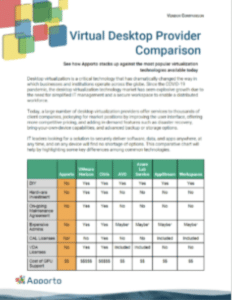The Most Critical Market Trends in Higher Education – Part 2
In Part 1, we examined the first two critical trends affecting the higher education market. Those being: Digital Equity and BYOD Support. In this article, we’ll look at the remaining three trends facing IT leaders.
Rethink, Repurpose, and Reclaim
First up is the desire to rethink, repurpose, and reclaim space across campus. This can be to create collaborative learning spaces or to convert back to instruction spaces, or something different altogether. High on the list for most campuses are to reimagine the “old and dusty” computer labs. Moving the delivery of these workstations to something more flexible enables campuses to reclaim the valuable real estate they so desperately seek. But how?
One solution to this problem is shifting to on-premise VDI (virtual desktop infrastructure), however, this is a very expensive and complex initiative. Most schools will spend close to $1mil in investment and 6 months to a year of planning and execution.
A better option is to move those physical labs to the cloud. Here, there are two distinct approaches: Do-it-yourself (DIY) or a managed service, like Apporto. While the DIY option probably feels like the cheaper option, that’s not always the case. There are many horror stories in the news where a newly appointed cloud admin got a configuration wrong and campus data became publicly available, as well as concerns and reports over excessive monthly bills. I recently spoke to a school that let faculty members create and manage their own cloud desktops. Unfortunately, they had one faculty build a massive research desktop and then forget to power it off over the holiday break. Administrators were shocked when faced with a $50,000 cost overrun just for the month of December!
This points to choosing a managed service provider for the school’s cloud computing needs, but not all managed service offerings are created equal. Oftentimes, the provider does not want to be responsible for customer mistakes and therefore will lock and prevent access to the school’s own environment. This creates a bit of a hostage situation where the customer is now beholden to the time, availability, and charges for the managed service provider to complete basic tasks. (We do things differently at Apporto.)
This leads us to our fourth market trend: Cloud First.
Does every workload belong in the cloud? Many colleges and universities are coming to the conclusion that no, in fact, they don’t. What we’re starting to see more of is a Cloud Smart approach where IT leaders are looking closely at the benefits and costs of moving specific workloads to the cloud.
One cloud model that is certainly outpacing all others is that of SaaS or software-as-a-service. We’re seeing this model adopted across all sectors of higher education, from enrollment systems to finance, from learning management systems to even some academic software titles. SaaS is probably the easiest way to move systems to the cloud – think Netflix – and is how we built our offering at Apporto.
Virtual Desktop Provider Comparison
Shrinking IT Budget
The final market trend facing higher education has also been around for years, but certainly is more prevalent in these days of the great resignation, uncertain economic times, and constant upheaval in the job market: Shrinking IT Budgets. Anyone who works in education is no stranger to this trend.
As if to add insult to injury, IT leaders are trying to consider the previous four trends we covered, find and implement solutions, and do so without any extra budget or staff. Here is where it pays to be Cloud Smart and find a vendor that can help address all of the prevailing market trends and deliver a solution at a reasonable price.
In addition to the trends mentioned earlier, it is important to keep an eye on unexpected trends, as well. Recent months have shown that unexpected developments, such as the emergence of ChatGPT, can quickly become game-changers in the industry. In the past, other trends like the Mac vs. Windows debate and the early days of the Internet were similarly unexpected and had a significant impact on the industry. Higher education leaders face the challenge of being able to change, pivot, adopt, or defend against new technologies with agility. While most schools I’ve spoken with have a 5-year strategic plan for vision-level planning, they often struggle with the details and integration when it comes to new technologies. Therefore, it is crucial for leaders to be prepared for the unexpected and to approach it with a positive mindset. Overall, embracing the unexpected can lead to innovative solutions and better outcomes for the education industry.
Conclusion
I would submit that while the landscape for campus computing has changed dramatically in recent years, there are good options available for all use-cases. It’s important to be flexible with long-term plans and seek out solutions that balance staff effort against cost, but that don’t negatively impact the student experience. I have a solution in mind. What about you?
Happy Computing!



